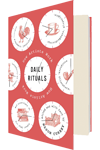For a while now, conventional wisdom has been throwing cold water on the idea of artistic genius. Forget the Shakespeare who “never blotted a line” and the Keats who wanted poems to come as naturally “as leaves to a tree.” If you want to achieve something great, tack to your mirror that Edison quotation about 99 percent perspiration and 1 percent inspiration; ponder Malcolm Gladwell’s summary of the ten-thousand-hour rule. Mason Currey’s Daily Rituals, a collection of short biographical descriptions of artists’ routines, seems right in step with this trend. It wants to offer a compendium of evidence for the effort-trumps-all theory in creativity studies: “Work work work,” Currey says by way of summarizing his project. This could mark the moment at which art, too, joins our current productivity-mad culture: if you like the Pomodoro Technique and the Fitbit, try the Trollope (he set his watch to write 250 words every fifteen minutes) or the Hemingway (he entered his daily word count on a wall chart). Learn the artistic version of Getting Things Done.
Or, rather, learn how art upends that idea. The accumulation of examples in Daily Rituals, in fact, shows how often artists resist the driven directive to “work work work.” The schedules described are regular, sure, but they’re almost always limited. Most of the artists settle on a timetable that is consistent but abbreviated, with no more than four consecutive hours of creative activity. Some prefer a single stretch, like Thomas Mann’s morning; some, like Simone de Beauvoir, fit in two sessions around a long lunch. Those who spend more time in the office might keep “business hours” but write “for only a small portion of that time”—two hours, in Martin Amis’s case. The maximum, according to Chuck Close, is “three hours in the morning and three hours in the afternoon.” To try for more might be not just difficult but also outright harmful. Ask Descartes, who counted indolence as necessary and “made sure not to overexert himself.” The most prolific figures in the book are not those who worked the longest: Georges Simenon, who published over four hundred books, wrote for only a few hours a day.
This means that writers who took other jobs to pay the bills—Kafka at an insurance office, Orwell at a bookstore—aren’t at much of a disadvantage. An artist’s schedule is important, Currey’s book reminds us, for its refusal to squeeze...
You have reached your article limit
Sign up for a digital subscription and continue reading all new issues, plus our entire archives, for just $1.50/month.
Already a subscriber? Sign in





